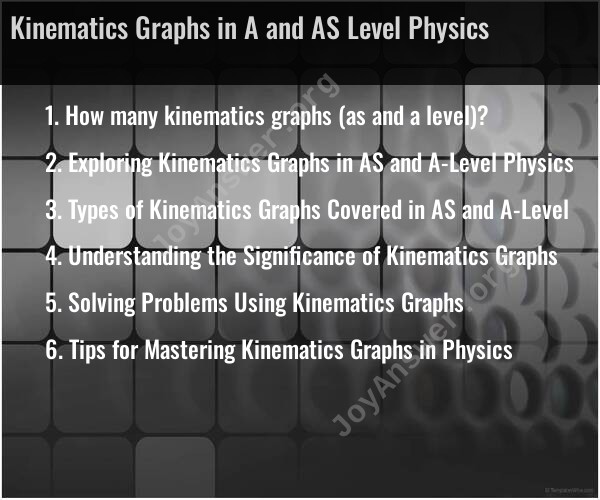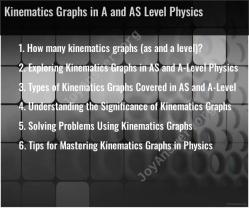How many kinematics graphs (as and a level)?
In A and AS level physics, you may encounter various kinematics graphs that are used to represent the motion of objects. The specific number and types of kinematics graphs covered in the curriculum can vary depending on the exam board or educational program you are following. However, there are several common types of kinematics graphs that are typically included in physics courses:
Position-Time Graph (s-t graph):
- This graph represents an object's position (displacement) as a function of time. The slope of the graph at a given point corresponds to the object's velocity.
Velocity-Time Graph (v-t graph):
- This graph shows an object's velocity as a function of time. The area under the graph represents the displacement of the object. The slope of the graph at a given point corresponds to the object's acceleration.
Acceleration-Time Graph (a-t graph):
- This graph illustrates an object's acceleration as a function of time. The area under the graph represents the change in velocity (final velocity - initial velocity).
Speed-Time Graph:
- Some curricula include speed-time graphs, which show an object's speed (scalar) as a function of time. These graphs can provide insights into the overall motion of an object, particularly when it changes direction.
Displacement-Time Graph (x-t graph):
- While less common, displacement-time graphs can be used to represent an object's displacement as a function of time. These graphs are similar to position-time graphs.
Jerk-Time Graph (j-t graph):
- Jerk is the rate of change of acceleration. Some advanced physics courses may include jerk-time graphs to explore higher-order derivatives of motion.
The number and complexity of kinematics graphs you encounter may depend on the depth and breadth of the physics course you are taking. Additionally, it's important to understand how to interpret and use these graphs to analyze the motion of objects, calculate various kinematic quantities, and solve physics problems related to motion.
It's recommended to consult your specific course materials, textbooks, or your instructor to determine which kinematics graphs are covered in your A or AS level physics curriculum and to gain a thorough understanding of how to work with them effectively.
Exploring Kinematics Graphs in AS and A-Level Physics
Kinematics graphs are a powerful tool for understanding and analyzing motion. They can be used to visualize the position, velocity, and acceleration of an object over time. Kinematics graphs are an essential part of AS and A-Level Physics, and students are expected to be able to interpret and use them to solve problems.
Types of Kinematics Graphs Covered in AS and A-Level
There are three main types of kinematics graphs:
- Position-time graphs: These graphs show the position of an object over time. The slope of a position-time graph represents the velocity of the object, and the area under the graph represents the displacement of the object.
- Velocity-time graphs: These graphs show the velocity of an object over time. The slope of a velocity-time graph represents the acceleration of the object.
- Acceleration-time graphs: These graphs show the acceleration of an object over time.
Understanding the Significance of Kinematics Graphs
Kinematics graphs are significant because they allow us to visualize the motion of an object in a way that is easy to understand. They can also be used to solve problems related to motion, such as determining the displacement, velocity, and acceleration of an object.
Solving Problems Using Kinematics Graphs
There are a number of different ways to solve problems using kinematics graphs. One common approach is to use the following steps:
- Identify the relevant graph. Which of the three types of kinematics graphs is most relevant to the problem?
- Interpret the graph. What information does the graph provide about the motion of the object?
- Apply the relevant equations. Use the equations of motion to calculate the desired quantity.
Tips for Mastering Kinematics Graphs in Physics
Here are some tips for mastering kinematics graphs in physics:
- Become familiar with the different types of kinematics graphs. What information does each type of graph provide?
- Practice interpreting kinematics graphs. What can you learn about the motion of an object from a given graph?
- Learn how to use kinematics graphs to solve problems. Practice solving problems that involve all three types of kinematics graphs.
Here are some additional tips:
- Pay attention to the units on the axes of the graph. This will help you to interpret the graph correctly.
- Look for patterns in the graph. Can you identify any trends or relationships in the data?
- Use the graph to make predictions. What will happen to the position, velocity, or acceleration of the object at a future time?
With practice, you will be able to master kinematics graphs and use them to solve problems confidently.


